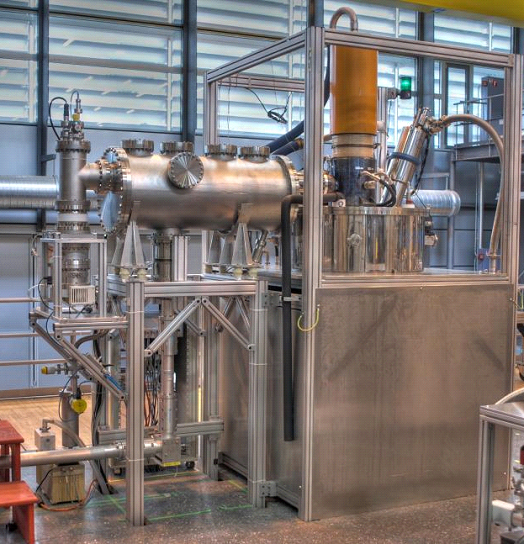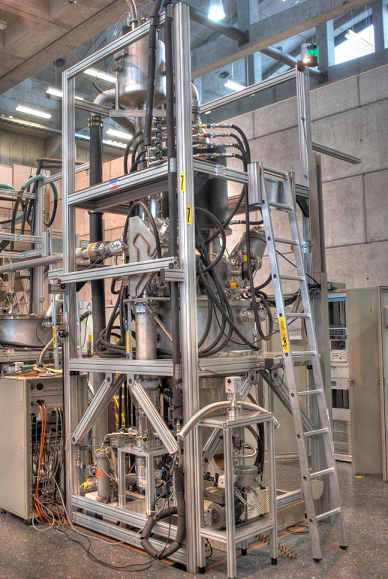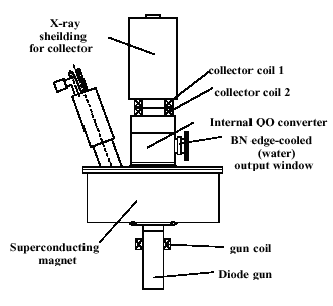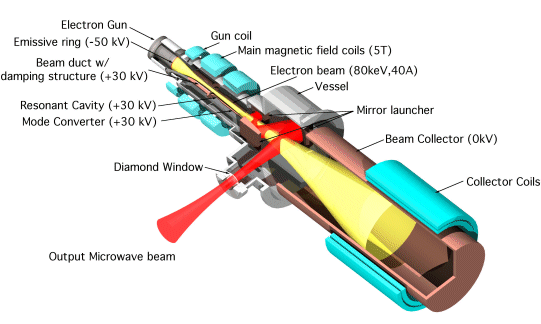General features of a gyrotron
Purpose and principle of operation
Gyrotrons are powerful microwave sources , i.e. they emit electromagnetic waves at very high frequency and intensity. Typically, their output power is in the order of hundreds of kW (the power of hundreds of kitchen microwaves) and their frequency around one hundred GHz (a thousand times higher than the modern radio broadcasting frequency). This gyrotron frequency corresponds to a wavelength of approx. 3 mm.
|
|
Coupling resonant electromagnetic microwaves to a plasma is one of the most common methods of plasma heating (yes there is a certain analogy to a microwave oven…). If the resonance condition is fulfilled, that means if the frequency of the microwaves excites one of the plasma proper frequencies, the waves can transfer their energy to plasma – which means they can heat the plasma.
A special case with the heating microwave frequency equal to the gyrofrequency of the plasma electrons (i.e. equal to the electron rotation frequency in the magnetic field which confines the plasma), or to its harmonics, is called Electron Cyclotron Resonance Heating ( ECRH ). And that’s why gyrotrons are applied – their frequency corresponds to the frequency of a significant ratio of electrons in hot plasmas of modern tokamaks.
Moreover, when the resonant electromagnetic wave has a component parallel to the toroidal magnetic field, it can support the electric current in the plasma ( ECCD ). For more details on ECRH and ECCD see the ECRH & ECCD physics page.
Configuration and functionality
|
|
|
Structure of the gyrotron with hollow electron beam (yellow) and excited microwave (red) |
The main parts of a gyrotron are an electron gun, an acceleration chamber, a resonance chamber (cavity) immersed in a strong magnetic field, a mode converter and finally of a collector of electrons, all of which are placed inside a vacuum tube.
· The electron gun produces a hollow beam of electrons, which rotate in a strong magnetic field. This beam is accelerated and changed in form by a changing electric and magnetic field.
· Inside the superconducting magnets, where the magnetic field is strongest, the relativistic electrons enter the resonance chamber (cavity). Because their rotational motion is the same as the resonance frequency of the cavity, they can interact with the electromagnetic wave inside the cavity. The rotating electric field of the wave decelerates the rotational motion of (most of) the electrons, so that the electrons give rotational energy to the wave. By this mechanism, the microwave is created inside the cavity.
· The hollow electron beams leaves the cavity in line with the microwave radiation. This radiation is transformed into another field profile (mode) in the mode converter and is directed via several mirrors to a window, where the radiation exits the gyrotron.
· The electron beam, which has given part of its energy to the microwave, continues in the same direction and is directed against the wall of the collector. This way, the remaining energy of the beam heats the collector wall, which makes an effective cooling of the collector necessary.
X2 gyrotrons for TCV
The TCV gyrotron setup consists of nine gyrotrons with a total power of 4.5 MW, six of which operate at the second harmonic of the electron cyclotron frequency in the plasma and three operating at the third harmonic. All of these gyrotrons excite an X-mode wave in the plasma, which means that the electric field of the wave oscillates in the direction perpendicular to the magnetic field ( E1 │ B0 ), with both a longitudinal and a transverse component ( E1 ║ k and E1 │ k).
The six X2-gyrotrons have an operating frequency of 82.7GHz and a nominal power of 0.5MW over 2 seconds each. They were installed at TCV in two parts in 1996 and 1999 and are operated in 2 clusters of 3 gyrotrons each, with a common power supply for each cluster. Nevertheless, the transmission lines and launchers are seperate for each gyrotron.
These gyrotrons were purchased from GYCOM-NN, Russia, who also was responsible for the design. They operate with a Diode-Magnetron-Injection (MIG) electron gun with a lanthanum hexaboride (LaB6) cathode emitter. The thermal design is ‘ballistic’ so the internal pieces (collector, cavity, etc) store thermal energy during a pulse and are cooled by water flow between pulses. The output is an edge-cooled boron-nitride window with a flattened Gaussian-output beam. The matching optics unit (MOU) then couples the beam to the evacuated transmission line.

|
The X2 gyrotron: the superconducting magnet ( cylindrical vessel above shielding box), the collector (yellow), the RF Conditioning Unit (cylindrical, towards the left), leading into the transmission line (downwards, then left) |
.
X3-Gyrotrons for TCV
The 118 GHz X3-gyrotrons were developed in the frame of the European gyrotron Research & Development effort, in partnership between Thomson Tubes (Thales), CRPP Lausanne, CEA Cadarache, KIT Karlsruhe and NTUA Athens. They were constructed by Thomson Tubes and are designed for 210s operation at 480kW (used only for 2 s). The hollow electron beam is produced by a triode MIG-gun. The output beam from the sapphire window (LN2 cooled) is >96% gaussian. Attached to the gyrotron is a matching optics unit, which couples the beam to the HE11 waveguide with >93% mode purity.

|
X3-gyrotron, with superconducting magnet (vessel at bottom of 1st stage), collector (grey cylinder above), transmission line (leaving to the left, middle) and the Matching Optics Unit (connected to transm. line). |
The same gyrotrons are also used at the Tore Supra tokamak of the CEA at Cadarache (France). There the 118 GHz correspond to the fundamental frequency and the gyrotrons can be used in quasi-steady-state operation (600s/400kW). At the time of its design (end of the 80’s), the gyrotron was considered state-of-the-art of high power gyrotrons.
The European collaboration for gyrotron development continued after this successful cooperation with the design and test of the 140 GHz, 1 MW, CW gyrotrons for the Wendelstein-7X stellarator in Greifswald (Germany), working at the 2nd harmonic of the electron cyclotron frequency. The cooperation is still going on and resulted in the European GYrotron Consortium (EGYC), working together with Thales on the development of the european contribution of gyrotrons for the ITER project in Cadarache (France) and also for the development of gyrotrons in prospect of the DEMO-project, planned to be built succeeding a succesful operation of ITER.
The following table will summarize some of the major features of the two types of gyrotrons:
|
|
X2 |
X3 |
|
No. of units |
6 |
3 |
|
Frequency [GHz] |
82.7 |
118 |
|
Development |
Gycom (Russia) |
EU gyrotron R&D collaboration |
|
Power |
500kW for 2s |
500kW for 2s (400kW/210s @CEA) |
|
Output mode |
|
TEM00 |
|
Cavity mode |
|
TE22,6 |
|
Window |
BN (watercooled) |
Sapphire, liq. N2 cooled |
|
Gun |
MIG Diode |
MIG Triode |
|
RFCU |
4 mirrors, 13% losses |
3 mirrors, <2% losses |
|
Launching |
6 launchers lateral |
1 launcher, vertical |

